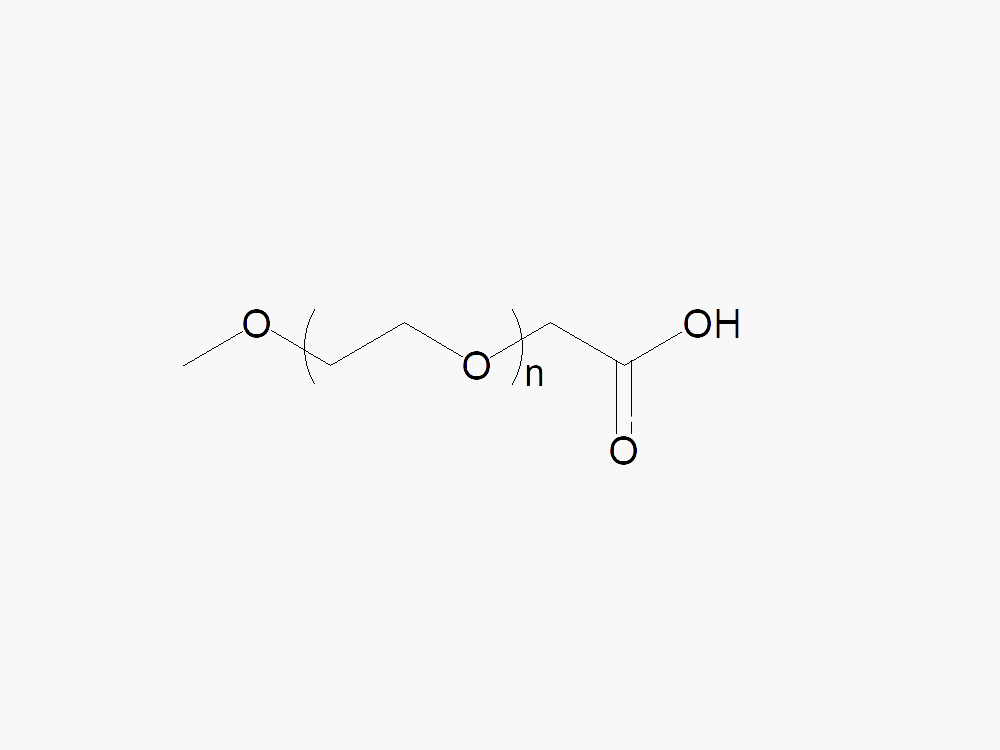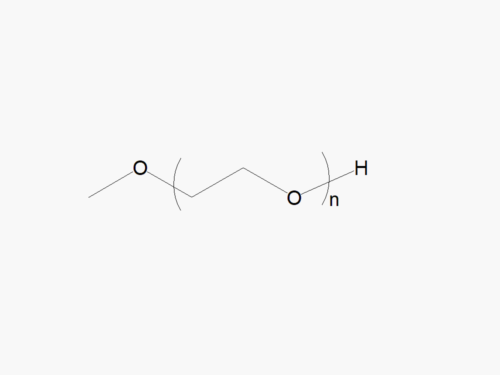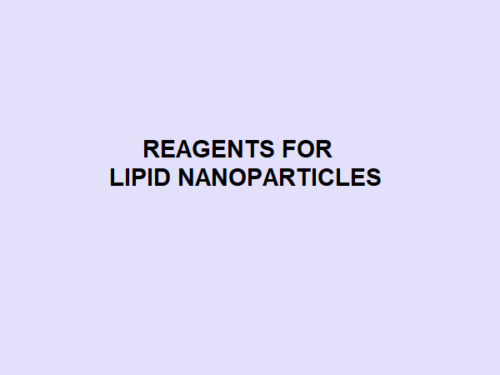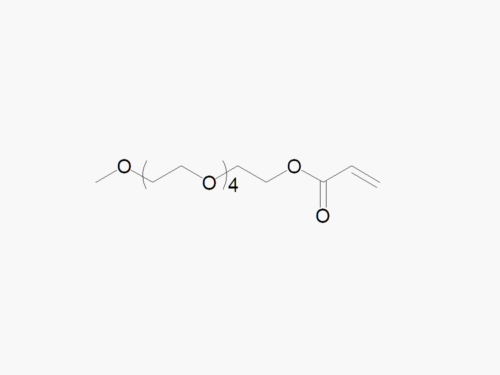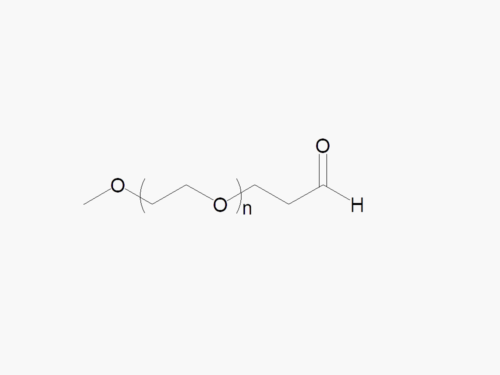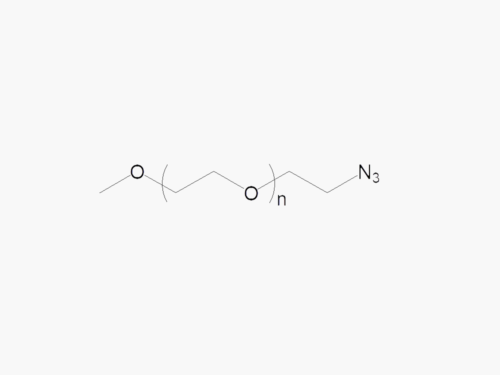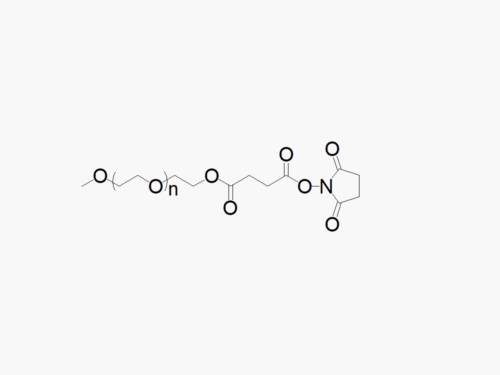PEG products with additional MW may be made to order, please contact us for details
Methoxy PEG Acetic Acid
$100.00 – $800.00
Description
Methoxy PEG Acetic Acid with superior quality specification of ≥95% Substitution.
Methoxy PEG Acetic Acid from JenKem Technology is an Amine PEGylation reagent reactive towards the amino group of lysine(s) at pH 7-8. Methoxy PEG Acetic Acid is more stable than M-PEG-SCM. JenKem Technology offers Methoxy PEG Acetic Acid with MW 2000 (M-CM-2000), MW 5000 (M-CM-5000), MW 10000 (M-CM-10K) and MW 20000 (M-CM-20K), in 1g and 10g packing sizes.
Different MW of Methoxy PEG Acetic Acid products may be available by custom synthesis, please email us at tech@jenkemusa.com for details on custom PEGs. JenKem Technology provides repackaging services for an additional fee, please contact us if you require a different package size than our catalog selection.
Bulk PEGs and GMP grade PEGs are made-to-order. Please contact us for bulk pricing.
Click here to download the MSDS
Note: Starting July 2016, Methoxy PEG Acetic Acid is the new name of the product Methoxy PEG Carboxyl (MW 2000 (M-COOH-2000), Methoxy PEG Carboxyl (MW 5000 (M-COOH-5000), MW 10000 (M-COOH-10K) and MW 20000 (M-COOH-20K)). JenKem Technology has revised the name of the product to better reflect the chemical structure, as many other PEG derivatives with a COOH group are offered in our catalog.
References:
- Shirasu, T., et al., Neointima abating and endothelium preserving — An adventitia-localized nanoformulation to inhibit the epigenetic writer DOT1L, Biomaterials, 301, 2023.
- Liu, Y., et al., Cathodic protected Mn2+ by NaxWO3 nanorods for stable magnetic resonance imaging-guided tumor photothermal therapy, Biomaterials, 2020, V. 234.
- Javanmardi, S., et al., Redox-Sensitive, PEG-Shielded Carboxymethyl PEI Nanogels Silencing MicroRNA-21, Sensitizes Resistant Ovarian Cancer Cells to Cisplatin, Asian Journal of Pharmaceutical Sciences, 2018.
- Lassenberger, A., et al., Individually stabilized, superparamagnetic nanoparticles with controlled shell and size leading to exceptional stealth properties and high relaxivities. ACS Applied Materials & Interfaces, 2017.
- Dai, L., et al., Self-assembled PEG–carboxymethylcellulose nanoparticles/α-cyclodextrin hydrogels for injectable and thermosensitive drug delivery. RSC Advances, 2017, 7(5):2905-12.
- Zhao, L., et al., An intraocular drug delivery system using targeted nanocarriers attenuates retinal ganglion cell degeneration. Journal of Controlled Release, 2017.
- Jones, S.K., et al., Revisiting the value of competition assays in folate receptor-mediated drug delivery, Biomaterials, 2017.
- Gal, N., et al., Interaction of size-tailored PEGylated iron oxide nanoparticles with lipid membranes and cells. ACS Biomaterials Science & Engineering. 2017, 3(3):249-59.
- Wang, Y., et al., Self-assembled nanoparticles based on poly (ethylene glycol)–oleanolic acid conjugates for co-delivery of anticancer drugs, RSC Advances, 2017, 7(47):29591-8.
- Chen, G., et al., Unimolecular Micelle-Based Hybrid System for Perivascular Drug Delivery Produces Long-Term Efficacy for Neointima Attenuation in Rats, Biomacromolecules, 2017.
- Farvadi, F., et al., Polyionic complex of single-walled carbon nanotubes and PEG-grafted-hyperbranched polyethyleneimine (PEG-PEI-SWNT) for an improved doxorubicin loading and delivery: development and in vitro characterization. Artificial cells, nanomedicine, and biotechnology, 2016, 1-9.
- Li, Y., et al., A graphene quantum dot (GQD) nanosystem with redox-triggered cleavable PEG shell facilitating selective activation of the photosensitiser for photodynamic therapy, RSC Adv., 2016, 6, 6516-6522.
- Jones, S.K, et al., Folate Receptor Targeted Delivery of siRNA and Paclitaxel to Ovarian Cancer Cells via Folate Conjugated Triblock Copolymer to Overcome TLR4 Driven Chemotherapy Resistance, Biomacromolecules, 2016, 17 (1), 76-87.
- Chaudhary, R., et al., Engineered atherosclerosis-specific zinc ferrite nanocomplex-based MRI contrast agents. Journal of Nanobiotechnology, 2016, 14(1):1-7.
- Abolmaali, S.S., et al., Chemically crosslinked nanogels of PEGylated poly ethyleneimine (l-histidine substituted) synthesized via metal ion coordinated self-assembly for delivery of methotrexate: Cytocompatibility, cellular delivery and antitumor activity in resistant cells. Materials Science and Engineering, 2016, C, 62, pp.897-907.
- Brinkman, A.M., et al., Aminoflavone-loaded EGFR-targeted unimolecular micelle nanoparticles exhibit anti-cancer effects in triple negative breast cancer. Biomaterials, 2016, 101:20-31.
- Li, C. et al., A self-assembled nanoparticle platform based on poly(ethylene glycol)–diosgenin conjugates for co-delivery of anticancer drugs, RSC Adv., 2015, 5, 74828-74834.
- Najafi, H., et al., Serum resistant and enhanced transfection of plasmid DNA by PEG-stabilized polyplex nanoparticles of L-histidine substituted polyethyleneimine, Macromolecular Research, 2015, 23:7, p. 618-627.
- Saraswathy, M., et al., Multifunctional drug nanocarriers formed by cRGD-conjugated βCD-PAMAM-PEG for targeted cancer therapy, Colloids and Surfaces B: Biointerfaces, 2015, 126, p. 590-597.
- Chen, G., et al., Multi-functional self-fluorescent unimolecular micelles for tumor-targeted drug delivery and bioimaging, Biomaterials 2015, 47, P. 41-50.
- Xiong, D, et al., GX1-mediated anionic liposomes carrying adenoviral vectors for enhanced inhibition of gastric cancer vascular endothelial cells, International Journal of Pharmaceutics, 2015, 496:2, p. 699-708.
- Guo, J., Theranostic Unimolecular Micelles Based on Brush-Shaped Amphiphilic Block Copolymers for Tumor-Targeted Drug Delivery and Positron Emission Tomography Imaging, ACS Appl. Mater. Interfaces, 2014, 6(24), p: 21769–21779.
- Xu, P., et al., Hydrogen-bonded and reduction-responsive micelles loading atorvastatin for therapy of breast cancer metastasis. Biomaterials, 2014, 35(26), p. 7574-7587.
- Gajbhiye, V., et al., Drug-loaded nanoparticles induce gene expression in human pluripotent stem cell derivatives. Nanoscale, 2014, 6(1), p. 521-31.
- Abolmaali, S.S., et al., Sequential optimization of methotrexate encapsulation in micellar nano-networks of polyethyleneimine ionomer containing redox-sensitive cross-links, International Journal of Nanomedicine, 2014, 9:2833-2848.
- Guo, J., et al., Image-guided and tumor-targeted drug delivery with radiolabeled unimolecular micelles, Biomaterials, 2013, 34(33), p: 8323–8332.
- Gao, X., et al., Prostate stem cell antigen-targeted nanoparticles with dual functional properties: in vivo imaging and cancer chemotherapy. Int J Nanomedicine, 2012, 7: p. 4037-51.
- Jiang, X., et al., Self-aggregated pegylated poly (trimethylene carbonate) nanoparticles decorated with c(RGDyK) peptide for targeted paclitaxel delivery to integrin-rich tumors, Biomaterials, 2011, 32(35), p:9457–9469.
Founded in 2001 by experts in PEG synthesis and PEGylation, JenKem Technology specializes exclusively in the development and manufacturing of high quality polyethylene glycol (PEG) products and derivatives, and related custom synthesis and PEGylation services. JenKem Technology is ISO 9001 and ISO 13485 certified, and adheres to ICH Q7A guidelines for GMP manufacture. The production of JenKem® PEGs is back-integrated to in-house polymerization directly from ethylene oxide, enabling facile traceability for regulated customers. JenKem Technology caters to the PEGylation needs of the pharmaceutical, biotechnology, medical device and diagnostics, and emerging chemical specialty markets, from laboratory scale through large commercial scale.

